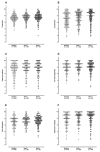Measuring Productivity, Perceived Stress and Work Engagement of a Nationally Delivered Workplace Step Count Challenge
- PMID: 35162865
- PMCID: PMC8835687
- DOI: 10.3390/ijerph19031843
Measuring Productivity, Perceived Stress and Work Engagement of a Nationally Delivered Workplace Step Count Challenge
Abstract
Workplace step count challenges show promise with regard to increasing physical activity, with walking linked to many positive physical and mental health benefits. Few studies have investigated their effects on work-related outcomes. The aim of this study was to describe (1) the process of collecting work-related outcomes as part of a real-world workplace intervention, the Step Count Challenge, and (2) report step counts and work-related outcomes (productivity, perceived stress and work engagement) during the Step Count Challenge. This pre-post study was conducted as part of a four-week 2018 National Step Count Challenge (SCC) in Scotland, UK. A survey was administered to collect self-reported steps, productivity (HWQ), perceived stress (Cohen Perceived Stress Scale) and work engagement (UWES) on the week prior to the intervention starting (baseline), week 1 and week 4. Process data such as recruitment and response rates were monitored throughout. Of 2042 employees who signed up to the SCC, baseline data were reported for 246 (12% of total; mean age 42.5 years, 83% female). Process data suggest low uptake to the study and poor compliance between surveys time points. Preliminary data suggest positive changes in step counts (3374 steps/day by week 4), stress and productivity. No changes in work engagement were found. The findings highlight the need to integrate research more effectively into real-world interventions, including a true baseline period. The Step Count Challenge may have positive change on some work-related outcomes warranting further investigation into how robust research designs can be delivered without negatively influencing real-world interventions.
Keywords: physical activity; productivity; steps; stress; walking; work engagement; workplace.
Conflict of interest statement
Carl Greenwood in an employee of Paths for All and a co-author on this paper. However, he had no input into the analysis and interpreting of the results. Paths for all is a Registered Scottish Charity No: SC025535.
Figures




Similar articles
-
The Effectiveness of an Annual Nationally Delivered Workplace Step Count Challenge on Changing Step Counts: Findings from Four Years of Delivery.Int J Environ Res Public Health. 2021 May 12;18(10):5140. doi: 10.3390/ijerph18105140. Int J Environ Res Public Health. 2021. PMID: 34066211 Free PMC article.
-
Change in work day step counts, wellbeing and job performance in Catalan university employees: a randomised controlled trial.Promot Educ. 2008 Dec;15(4):11-6. doi: 10.1177/1025382308097693. Promot Educ. 2008. PMID: 19066233 Clinical Trial.
-
Association between working hours, work engagement, and work productivity in employees: A cross-sectional study of the Japanese Study of Health, Occupation, and Psychosocial Factors Relates Equity.J Occup Health. 2019 Mar;61(2):182-188. doi: 10.1002/1348-9585.12023. Epub 2019 Feb 22. J Occup Health. 2019. PMID: 30793826 Free PMC article.
-
Workplace interventions for increasing standing or walking for decreasing musculoskeletal symptoms in sedentary workers.Cochrane Database Syst Rev. 2019 Nov 17;2019(11):CD012487. doi: 10.1002/14651858.CD012487.pub2. Cochrane Database Syst Rev. 2019. PMID: 31742666 Free PMC article.
-
The effects of step-count monitoring interventions on physical activity: systematic review and meta-analysis of community-based randomised controlled trials in adults.Int J Behav Nutr Phys Act. 2020 Oct 9;17(1):129. doi: 10.1186/s12966-020-01020-8. Int J Behav Nutr Phys Act. 2020. PMID: 33036635 Free PMC article.
Cited by
-
Building partnerships: A case study of physical activity researchers and practitioners collaborating to build evidence to inform the delivery of a workplace step count challenge.Front Sports Act Living. 2023 Jan 4;4:1067127. doi: 10.3389/fspor.2022.1067127. eCollection 2022. Front Sports Act Living. 2023. PMID: 36685059 Free PMC article.
References
-
- Church T.S., Thomas D.M., Tudor-Locke C., Katzmarzyk P.T., Earnest C.P., Rodarte R.Q., Martin C.K., Blair S.N., Bouchard C. Trends over 5 Decades in U.S. Occupation-Related Physical Activity and Their Associations with Obesity. PLoS ONE. 2011;6:e19657. doi: 10.1371/journal.pone.0019657. - DOI - PMC - PubMed
MeSH terms
LinkOut - more resources
Full Text Sources
Research Materials

